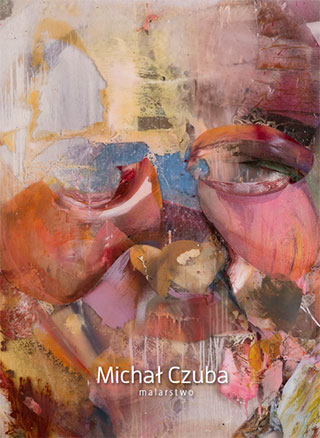 |
|
Michał Czub »
painting


The energy of a painting matter
Intensifying the reality, Michał Czuba affects our senses.
He achieves it dealing with a chosen genre of painting –
a portrait (and self-portrait).
The artist uses various painting techniques on a plane. Some
fragments of a painting are almost dripping, not opaque,
like in one of the varieties of glass painting in which, for
example, tempera is used. Thus some parts of the plane
are covered with smears of dribbling paint. Elsewhere, the
coloured substance is opaque; the thick impasto reflects
the author’s lively temper. We will also notice spots where
the paint, enriching the living tissue of the painting, creates
almost organic, clump-like clusters. Thick impasto layers or
transparent planes have different functions from the point
of view of the technique, yet they all constitute an equally
important tool in the process of shaping the expressive
values of the painting. One could say that the dominant
feeling accompanying the perception of these particular
works is their expressiveness.
Thanks to the applied technical measures, as well as due to
the vivid, uncontrolled colour composition, surprising colour
combinations, Michał Czuba presents his heroes as dramatis
personae on an opera stage along with all the splendour of
form typical of this convention. And he does it almost like in
the cinematic close-up.
First the interpreted theme is kept under observation.
However, even when the painting process is preceded by an
initial sketch, the artist’s dynamic gestures are not subject to
the discipline of the contour that restricts them. The effect
acquires an analytical value, it is strengthened by the spatiality
of the work achieved with original means of expression, by
taking into account the role of the background located at
a certain distance from the essential image.
The human face becomes a field of formal experiments.
The artist passionately attacks the surface of the painting.
He shapes his vision in an almost faceted manner, with
deformations and image displacement. He prepares it as if
he wanted to destroy it. Despite being transformed in the
process of creation, likenesses are still related to the original.
Does the painter ‘take it out’ on the model? Are we dealing
with art blurring reality? Or perhaps the author of the artwork
would like to tell us that a neat portrait in the traditional
scenery does not make any sense today, that ‘an object is not
an end itself. It is used to point to the general situation of
things…’2
We also get an impression that the author shares Giacometti’s
conviction that the painting cannot be completely finished
and that the artist should perceive the world with all senses
and describe it as a whole, not as a sum of particular elements.
Trying to place Michał Czuba’s portraits in a broader artistic
context, we could definitely recall here the influences of
various traditions, above all those that expose the emotional
depth and the artist’s desire of self-expression, such as
Abstract Expressionism or the new figuration.
In spite of being a reaction to meeting different people and
personalities, the images make up one dramatic portrait
of a human being. Figures rendered with expressive brush
strokes define their existential situation. In fact, the artist
creates his and theirs, models’ traces of existence in reality.
Leaving such a trace does not require a fully developed,
detailed whole. Once it used to be an impression of a hand
left on a rock, an imprint of a painted human body on the
surface of a painting, the effect of a sweeping gesture of
a hand armed with a brush in the ‘live painting theatre’.
What strikes us in the paintings by Michał Czuba is a lack
of relation between the object and the surroundings. As
a matter of fact there are a lot of images that break out
of the background. It is not necessary. The portrait itself is
a sign, a dramatic message that sounds in space. It is made
of molecules of colour and light. Nevertheless, due to the
dynamics of form we do not forget that the figure does not
exist only as a set of sensory elements. It is only the context
that remains ‘out of frame’.
The use of a translucent panel as a painting support has
additional effects resulting from the juxtaposition of the
main motif and the background that is away from it. The
colourful composition has an impact on the ultimate
colour effect of the whole, extra fragments laminated in the
background together with the layers of lacquer that break
on the surface are a source of textural surprises. All these
factors additionally strengthen the image’s dynamics, just
like wrinkles, cracks and scars on the face sculpt its surface,
making it more intriguing.
The transparent support makes us perceive the unframed
painting as if it was part of the space that surrounds it, not
something external. For other painters that kind of panel
is only a palette, an auxiliary element where paints are
prepared. In Michał Czuba’s artwork it takes over the entire
expression of the artist’s actions. Traces of paint extend
beyond the boundaries of the painting support; they
‘smudge’ the surrounding area. In a sense, the interior of
the painter’s studio, the objects that fill it and the paintings
themselves create unity.
The matter, which usually defines the existence of the
components of reality, here as the physical component of
the creative process, a tangible, strongly exposed layer of the
medium transforms into an image in the dynamic process of
creation – it becomes the essence of this space.
------------------------------------------------------------------------
2 H. Ohff, Galerie der neuen Kunste, Gutersloh 1971, p. 43. As cited in
Piotr Krakowski, O sztuce nowej i najnowszej, Warszawa 1981, p. 122.
Dariusz Le¶nikowski
Transl. Elżbieta Rodzeń-Le¶nikowska

 KATALOG
KATALOG
|
|
|
 |










